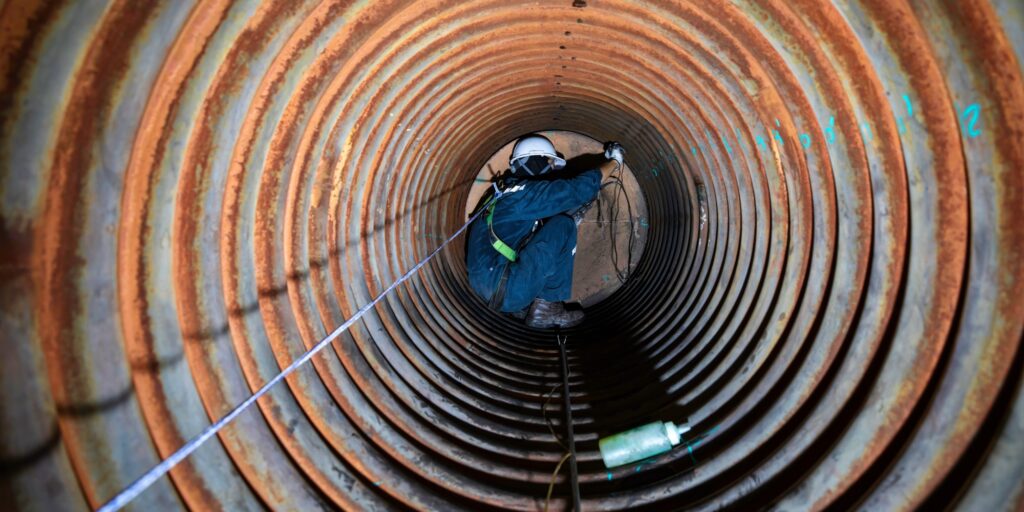
Ressources / Guide / What Is Rope Access? [New for 2025]
Guide
What Is Rope Access? [New for 2025]
Rope access is the professional use of ropes to do inspections, maintenance, and other types of work.
The use of ropes in industrial settings was pioneered by explorers who first used ropes in caving and climbing, and has since been adapted for many different types of work.
To gain access to inaccessible areas, rope access is commonly used along with various climbing techniques and—of course—safety equipment. It’s also used in challenging or dangerous environments like confined spaces, on work sites above water, or in limited spaces within buildings, allowing people to work at height safely and efficiently while avoiding obstacles.
[Rope access is commonly used for non-destructive testing, also known as NDT. Learn more about NDT in this in-depth guide.]
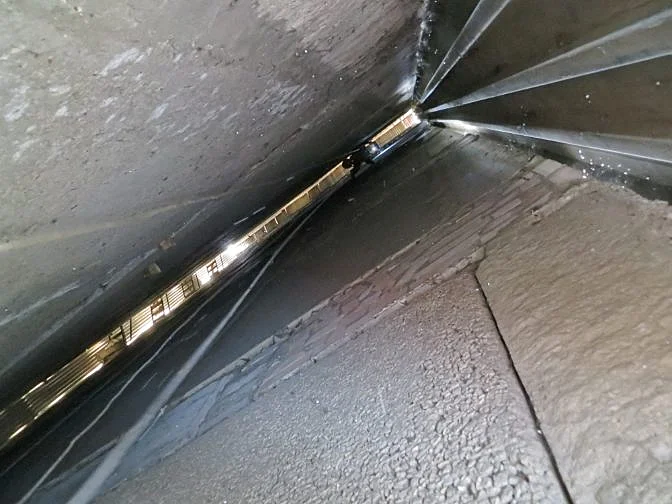
What Is Rope Access?
The primary purpose of ropes access is to enable workers to access difficult-to-reach locations without scaffolding, cradles, or aerial platforms.
A rope access technician will use ropes to descend, ascend, or traverse ropes while held in place by a harness, and sometimes a rope access work seat as well.
Rope access first came into use for industrial work in the 1980s. Since then, trade associations like IRATA (Industrial Rope Access Trade Association) and SPRAT (Society of Professional Rope Access Technicians) have codified it and made it into a tested, reliable method for getting people into hard-to-reach places to do work.
These days, there is a wide array of rope access works and jobs that involve rope access.
In the civil sector, for instance, the most common uses are window cleaning, maintenance, and support.
In the industrial sectors, the most common uses are non-destructive testing (also simply known as inspections).
To satisfy rope access safety requirements, rope technicians commonly use a few different redundancies to ensure they’ll still be safe in case part of their equipment fails.
- A backup fall arrest system, which uses two ropes to provide a redundancy for safety—a working rope and a safety rope.
- Additional anchor points—a primary anchor point + two backup anchor points.
The main advantage of using ropes access lies in the speed and safety with which they allow workers to reach hard-to-reach locations in order to perform their work, often with minimal impact on other operations and surrounding areas.
Comparing the man-at-risk hours and associated risks and costs of access to such locations with other means of access, rope access generally reduces both the time workers are exposed to risk and the degree of that risk.
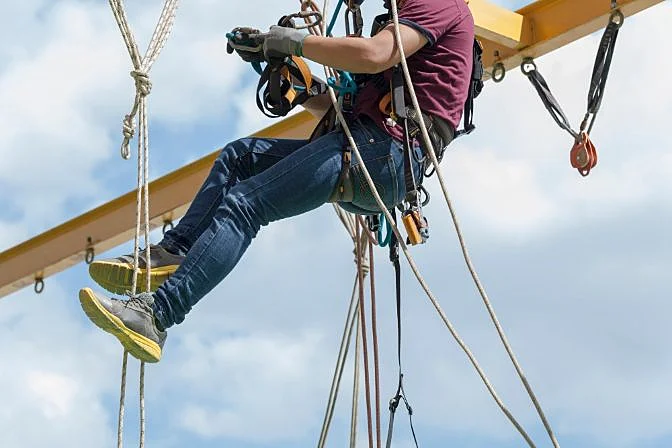
The Pros and Cons of Rope Access
Rope access is a widely used method for accessing hard-to-reach locations in various industries. While it offers several advantages, there are also limitations and considerations to keep in mind. Below, we explore the key pros and cons of using rope access for industrial work, maintenance, and inspections.
Pour
- Accessibilité. A rope access solution can always be found to reach an ‘inaccessible’ place, whether it is in height or depth.
- Sécurité. Working at height is generally a safe activity when conducted according to IRATA guidelines.
- Vitesse. A rope access system can be quickly constructed and dismantled. Because of this, it can be quickly set up and taken down when needed. There is very little inconvenience.
- Space. Compared to other methods for reaching challenging areas at height, rope access takes up very little space, which means that it doesn’t pose a significant disruption to a work site.
- Environmental considerations. Rope methods are considered environmentally friendly because they don’t require the transportation of large machinery, and because they allow people to reach worksite locations without clearing or adapting land.
Cons
- Perception. Although rope access is generally safe, many companies still feel wary about it because they have a perception that it is dangerous.
- Access. Ropes do not allow access to every single area where a person might need to go for the purposes of work.
- Directional limitations. Rope access systems are not powered, which means that they only allow a technician to go down, and not back up.
- Maintenance work limitations. Working on ropes limits the abilities for a person to do certain types of maintenance work, making some kinds of more intensive work impossible.
Rope Access Techniques and Systems
Here are the steps rope technicians generally take when doing their work:
- Préparation. This includes assessing potential risks for a given mission, establishing preventative measures as needed, and installing anchoring points and progression points (if they’re not already in place).
- Placement. Progress towards and away from the operating level, then getting positioned in the area where work will be done.
- Implementation. Doing the work required—conducting an inspection, cleaning, maintenance, or whatever other kind of work is needed.
- Debriefing and cleaning. Going over anything learned from the mission from a safety perspective and removing anchors and progression systems (unless regular activity requires them to stay in place).
Industrial Rope Access Systems
There are two common types of rope access systems, which are often used at the same time.
Note: When we say system here, we’re referring to a general approach to how the work is done, not a defined methodology.
The Dual Rope System
This is the system we referred to above, which uses redundancy to ensure safety. Using a Dual Rope System, a rope technician will have a primary rope and a secondary rope, with the second one in place as a backup in case the first one fails. The primary and secondary rope systems must always have at least two secure attachment points.
The Buddy System
The Buddy System is commonly used in conjunction with the Dual Rope System. It refers to the use of partners in rope work, so that rope technicians can rescue each other if one gets into trouble while working at height.
The Buddy System allows partners to rescue each other, while the Dual Rope System allows horizontal movement and self-rescue.
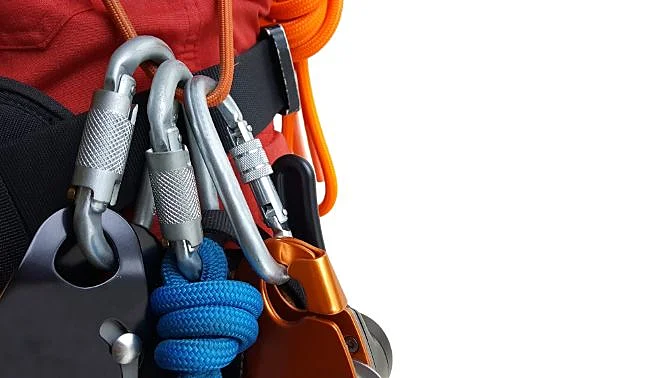
Rope Access Equipment List
There are many different types of equipment used in rope access work. Much of this equipment is explicitly designed to help satisfy rope access safety requirements and keep inspectors safe while working.
Here are the most common types of rope access equipment.
Ascenders
An ascender allows you to climb ropes.
This type of hitch works much like a friction hitch, sliding along the rope while empty, then locking into place when weight is applied. Unlike friction hitches, ascenders are mechanical and are safer and much easier to use.
Descenders
Workers or loads are lowered by using descenders, allowing them to do so at a controlled rate. This is achieved by using friction, just as ascenders do. Descenders should have a self-braking mechanism and an operator release mechanism.
Lanyards / Energy Absorbers
Harnesses are linked to anchors using lanyards and energy absorbers. A fall arrest system is the most prevalent type used in the industry, and it’s designed to reduce the force on the body in the case of a fall.
Harnesses
Types of harnesses used in rope access include full-body harnesses and seat harnesses. Full-body harnesses are more commonly used in rescue or industrial applications due to the number of attachment points they provide.
Helmets
Helmets provide protection against falling debris and other head-related hazards associated with rope access. Even though safety harnesses are mandatory on all construction sites, they are especially important when working at heights. This is essential to prevent orthostatic hypotension due to a restriction of blood flow if a worker has an accident that leads to a loss of consciousness.
Ropes
There would be no rope access without ropes. As well as being strong, ropes are lightweight and flexible.
This is not an exhaustive list of every piece of equipment used in rope access—other types include connectors, foot loops, mobile fall arrest devices, and pulleys.
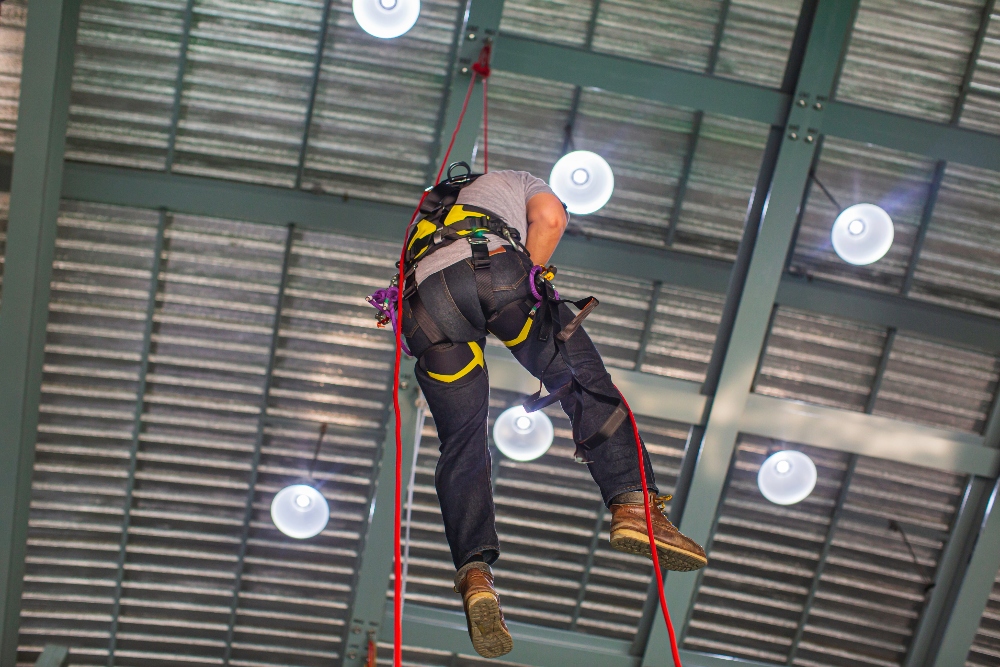
Rope Access Training
Training and qualifications required to get started in rope access can seem daunting—and with good reason.
Work on ropes is inherently dangerous. For that reason, rope access safety requirements and training to satisfy them are highly emphasized throughout the industry.
Both IRATA and SPRAT have mandatory training policies, as well as stringent reporting requirements for all members.
Certification Levels
There are three generally recognized certification levels for rope access training, each with different content and criteria.
Here is how these three technical grades are described by IRATA:
- Niveau 1. This level covers a variety of rope access maneuvers, the inspection of rigging equipment, and basic rescue procedures.
- Level 2. This level builds on level 1 training and teaches rope rigging, safety requirements, rescues, and quality assurance procedures.
- Level 3. This level teaches the most advanced rescue techniques and best practices, and allows rope technicians to work as site supervisors. A level 2 supervisor must log 1,000 hours on the ropes before attaining Level 3 certification.
In addition to training, a candidate’s health, fitness, strength, and coordination levels may also be considered as part of the certification process.
Learn more about the three training levels listed above on the IRATA website.
Preparing for Training
To make sure you’re not totally in the dark, it’s a good idea to brush up on some basic knowledge before you begin formal training.
Learn a little about work at height regulations, and familiarize yourself with some of the knots and supplies you will be using during rope access work. The rope access course is designed to introduce you to all the basics of rope access, but it’s better to begin training with some fundamental knowledge already in place.
The Training
It takes five days to complete a rope access training course.
Even if you have experience rock climbing or using ropes in some other capacity, it’s important to pay attention when entering rope access training since there are specific considerations for using ropes in a work environment.
While practical exercises are a major part of the training, theoretical lessons are also important and commonly taught during breaks between the exercises.
The Assessment
There are written and practical assessments at the end of each training course.
Assessments are conducted to ensure that trainees understand their responsibilities and can perform tasks safely as a team.
Here are some of the types of exercises that might be included in a rope access assessment:
- How to assemble a harness rig
- How to check equipment for faults
- How to perform rescue maneuvers
- The types of knots that can be tied
- Rope climbing
Throughout every maneuver, it is important to avoid dangling from only one rope without any backup, and to check that the mainline and safety line are both secure at every step of the process.
Rope Access vs. Remote Visual Inspection (RVI) Equipment
Rope access and remote visual inspection (RVI) equipment are both used for industrial inspections, but each offers unique benefits and trade-offs. While rope access has been a staple for reaching difficult-to-access locations, newer technologies like drones, robotic crawlers, and other RVI tools are offering significant advantages in safety, cost, and data quality. Below, we’ll compare these two methods and explore why RVI solutions are increasingly preferred in certain industrial scenarios.
Safety Benefits
One of the primary advantages of RVI equipment over rope access is safety. Rope access requires workers to perform tasks at height or in confined spaces, which exposes them to significant risks, including falls, equipment failure, or hazardous environments. Even with stringent safety measures in place, rope access can still be dangerous due to the inherent nature of working at height or in tight spaces.
In contrast, remote visual inspection tools like drones, robotic crawlers, and cameras allow operators to conduct inspections from a safe distance. These tools can be operated remotely, ensuring that no one is exposed to the risks associated with high places, confined spaces, or dangerous environments. This makes RVI solutions a much safer alternative, particularly in hazardous locations such as offshore platforms, power plants, and chemical processing facilities.
Cost-Effectiveness
Rope access typically requires workers to undergo extensive training, acquire specialized equipment (e.g., harnesses, ropes, safety gear), and take significant time to set up each job. For larger projects or locations that require frequent inspections, the cost of labor and equipment can quickly add up.
RVI equipment, however, offers a more cost-effective solution. Drones and robotic crawlers can reduce the need for highly trained workers at height, which lowers labor costs and minimizes the need for extensive setup. RVI systems can also reduce downtime by allowing inspections to be completed quickly and without interrupting ongoing operations. For instance, drones can fly to hard-to-reach areas almost immediately, eliminating the need for scaffolding or rope access teams to be set up each time an inspection is required.
Data Quality
Another significant advantage of RVI tools is the quality of data they can provide. While rope access allows inspectors to physically observe and assess equipment, RVI systems can capture far more detailed and accurate data through advanced sensors and imaging technologies.
RVI tools such as drones equipped with high-definition cameras, thermal imaging, and LiDAR can provide much clearer and more comprehensive visual data compared to traditional rope access methods. Drones and robotic crawlers equipped with thermal sensors can detect heat anomalies, while LiDAR can create highly detailed 3D maps of structures. These advanced capabilities enable more accurate assessments of equipment condition and facilitate more precise decision-making.
In contrast, rope access inspections are typically limited to visual inspections by the human eye, which can miss subtle issues or fail to capture detailed data that modern sensors can provide.
Flexibility in Reaching Difficult-to-Access Areas
While rope access provides a reliable means of reaching difficult areas, it still requires considerable effort to set up and can be constrained by the physical environment. In particular, setups for scaffolding or rigging can be time-consuming and may not be possible in locations with limited space or hazardous conditions. Rope access is also limited in its ability to quickly move across various inspection areas, especially if the site has multiple levels or complex geometry.
RVI tools, however, are incredibly flexible and versatile. Drones can quickly travel to hard-to-reach areas without needing elaborate setups. Robotic crawlers can navigate pipelines, confined spaces, or tanks where rope access would be difficult or unsafe. The ability of these RVI tools to quickly adapt to different environments makes them an invaluable solution for inspections in areas that are too difficult or dangerous for traditional rope access.
Applications Where RVI Equipment is Preferred
RVI tools are particularly beneficial in environments that are hazardous, confined, or difficult to access. Some specific applications where RVI equipment is often preferred include:
- Espaces confinés. Areas such as tanks, ducts, or underground pipes where rope access may be difficult or dangerous.
- Plates-formes offshore. Drones and robotic crawlers are ideal for inspecting hard-to-reach areas on offshore platforms without exposing workers to the hazards of height and weather conditions.
- Centrales électriques. RVI tools can inspect boiler units, turbines, and reactors from a safe distance, preventing workers from having to enter potentially dangerous areas.
- Inspections structurelles. In buildings or large infrastructure, RVI tools can access high or dangerous places (such as roofs or bridges) without the need for scaffolding or ladders.
As industries seek safer, more cost-effective solutions, remote visual inspection equipment is becoming the preferred alternative to rope access. It allows for a higher level of efficiency, accuracy, and safety while reducing the risks and costs associated with traditional inspection methods.
The Advantages of Using Drones and Robotic Crawlers Over Rope Access
In recent years, drones and robotic crawlers have emerged as powerful alternatives to traditional rope access for industrial inspections. These advanced technologies offer a range of advantages that make them more efficient, cost-effective, and safer than rope access, particularly for inspections in difficult-to-reach or hazardous areas.
Quick Deployment and Mobility
One of the most significant benefits of using drones and robotic crawlers is their quick deployment and mobility compared to rope access systems. While rope access requires significant setup time for scaffolding, rigging, and preparation, drones can be launched almost immediately, allowing inspections to start without delay. Robotic crawlers can be deployed into confined spaces with minimal setup, providing immediate access to areas where human entry is difficult or unsafe.
Fonctionnement à distance
Both drones and robotic crawlers can be operated from a safe distance, which is a major safety advantage over rope access. In traditional rope access, workers are exposed to risks such as falls or injuries from working at height or in confined spaces. Drones, operated remotely, eliminate this risk by keeping workers on the ground. Similarly, robotic crawlers operate autonomously or under remote control in hazardous environments, reducing the need for human presence in potentially dangerous areas.
Cost-Effectiveness
Using drones and robotic crawlers for inspections is often more affordable than rope access. Rope access requires specialized equipment, highly trained personnel, and extensive setup time for tasks like building scaffolding. Drones and robotic crawlers reduce or eliminate the need for scaffolding or rope access crews, leading to lower labor and equipment costs. Additionally, the speed of deployment and ability to perform inspections quickly can reduce downtime and operational disruptions, further enhancing cost savings.
Advanced Capabilities
Drones equipped with advanced imaging technologies such as thermal cameras, high-definition cameras, and LiDAR can capture detailed, accurate data that traditional rope access methods may not be able to provide. These tools allow for highly precise inspections and can detect issues that may be invisible to the naked eye or difficult to identify through visual inspection alone. For example, drones can detect heat anomalies, structural weaknesses, or corrosion in materials that might otherwise go unnoticed.
Robotic Crawlers for Confined Spaces
While drones are ideal for aerial inspections, robotic crawlers provide a perfect solution for inspecting confined spaces, pipelines, and areas that are not accessible by traditional means. These robotic systems can navigate tight spaces and operate in environments that may be hazardous to humans, such as areas with high levels of toxic gases or radioactive materials. Robotic crawlers are capable of providing real-time video footage and data collection, giving inspectors valuable insights without the need for human operators to enter dangerous areas.
Autonomous Features of Robotic Crawlers
Many robotic crawlers come with autonomous features that allow them to follow pre-programmed inspection paths, collect data in real time, and operate without a human operator being physically present in hazardous environments. This autonomy enhances the safety of inspections and allows for continuous, uninterrupted data collection in hard-to-reach areas. In industries like oil and gas, water treatment, and nuclear, these robotic crawlers are essential for inspecting critical infrastructure in unsafe or restricted environments.
Case Studies and Industry Adoption
Across various industries, drones and robotic crawlers are increasingly being adopted as the preferred method for inspections:
- Pétrole et gaz. Drones are used to inspect offshore platforms and pipelines, providing high-quality visual data while minimizing risk to personnel.
- Water Treatment. Robotic crawlers are deployed to inspect underground pipes and tanks, helping to identify issues without disrupting operations.
- Nucléaire. Robotic crawlers are used to inspect reactor cores and other high-radiation areas, ensuring safety while gathering critical data.
FAQ: Rope Access vs. Remote Inspection Alternatives
Here are answers to the most commonly asked questions about rope access and rope access alternatives for inspection data collection.
What is rope access?
Rope access is a technique that uses ropes to access difficult-to-reach locations for work such as inspections, maintenance, and repairs. It typically involves trained technicians using specialized ropes, harnesses, and safety equipment to work in hard-to-reach or hazardous environments, such as heights, confined spaces, or areas with limited access.
Why are drones and robotic crawlers considered alternatives to rope access?
Drones and robotic crawlers are considered alternatives to rope access because they allow for inspections and work to be performed remotely, reducing the need for human workers to physically access hazardous or difficult locations. These technologies provide a safer, more cost-effective, and efficient way to conduct inspections in environments where rope access might pose significant risks or logistical challenges.
What are the key advantages of using drones for inspections?
- Sécurité. Drones can operate remotely, reducing human exposure to risks such as working at height or in confined spaces.
- Cost-effectiveness. Drones eliminate the need for scaffolding or rope access crews, significantly reducing labor and equipment costs.
- Vitesse. Drones are quick to deploy and can conduct inspections more rapidly than rope access methods, minimizing operational downtime.
- Advanced imaging. Drones equipped with high-definition cameras, thermal sensors, and LiDAR can capture more detailed and accurate data than rope access methods.
How do robotic crawlers compare to drones and rope access for inspections?
Robotic crawlers are ideal for inspecting confined spaces, pipelines, and other hard-to-reach areas where drones cannot operate effectively. They can navigate tight spaces and work in hazardous environments, such as areas with high radiation or toxic gases. While drones excel in aerial inspections, robotic crawlers offer the ability to inspect underground or internally confined areas, providing real-time video footage and data without the need for human operators in risky environments.
What are the benefits of using remote visual inspection (RVI) tools over traditional rope access?
- Reduced human exposure to risk. RVI tools, like drones and robotic crawlers, eliminate the need for workers to be physically present in dangerous areas such as high altitudes, confined spaces, or toxic environments.
- Cost savings. RVI equipment can reduce labor costs and minimize the time spent on inspections compared to rope access, which requires specialized technicians and setup.
- Improved data quality. RVI tools, such as drones equipped with advanced imaging technology (thermal, HD cameras, LiDAR), often capture superior data compared to traditional rope access methods.
- Faster deployment. Drones and robotic crawlers can be deployed quickly and efficiently, reducing operational downtime during inspections.
How do drones and robotic crawlers enhance safety during inspections?
Both drones and robotic crawlers eliminate the need for human workers to physically access hazardous environments, reducing the risks of accidents. Drones allow for remote aerial inspections, while robotic crawlers can navigate confined or dangerous spaces autonomously, ensuring that workers are kept out of harm’s way. By using these technologies, industries can perform inspections with minimal risk and without exposing workers to dangerous conditions like falls, toxic gases, or confined space hazards.
Can drones and robotic crawlers provide detailed inspection data?
Yes, drones and robotic crawlers equipped with advanced sensors and cameras (thermal, high-definition, LiDAR, etc.) can capture high-quality visual data, detect temperature anomalies, assess structural integrity, and more. These technologies provide more detailed insights than traditional rope access methods and can detect issues like corrosion, cracks, and heat irregularities that might go unnoticed through visual inspection alone.
What industries benefit the most from using drones and robotic crawlers for inspections?
- Pétrole et gaz. Drones and robotic crawlers are used to inspect offshore platforms, pipelines, and other critical infrastructure in hazardous environments.
- Energy and Power Generation. Drones help monitor turbines, reactors, and boilers, while robotic crawlers inspect confined spaces like cooling towers and underground piping.
- La construction. Drones are used to survey construction sites, while robotic crawlers provide access to confined spaces in buildings or infrastructure.
- Water Treatment. Robotic crawlers inspect pipes, tanks, and filtration systems, providing real-time data without exposing workers to hazardous conditions.
- Nucléaire. Robotic crawlers are used to inspect reactor cores and other areas with high radiation, ensuring safety while collecting data in inaccessible areas.
What are the key features to look for in remote visual inspection (RVI) tools?
- High-resolution cameras. Ensure that the tool is equipped with cameras capable of capturing high-definition or thermal images for precise inspection.
- Autonomous operation. Look for RVI tools that can operate autonomously or follow pre-programmed paths, minimizing the need for manual control.
- Durabilité. RVI tools should be rugged enough to operate in harsh environments, including extreme temperatures, moisture, or hazardous areas.
- Data storage and transmission. The ability to store large amounts of data and transmit it in real-time to operators or decision-makers is essential for effective inspections.
How do drones and robotic crawlers improve productivity during inspections?
By eliminating the need for extensive setup, reducing worker exposure to risk, and offering faster deployment, drones and robotic crawlers improve productivity during inspections. These tools can be quickly deployed to hard-to-reach areas, gather detailed data, and send it back for analysis in real-time, reducing downtime and allowing for quicker decision-making. Additionally, with autonomous capabilities, these tools can operate without the need for constant human supervision, enabling inspections to continue even when human workers are unavailable or unsafe to perform the work.
What are the limitations of drones and robotic crawlers compared to rope access?
While drones and robotic crawlers offer numerous advantages, they are not suitable for every inspection scenario. For example, drones may have limited battery life, which could restrict their range and duration for larger or more complex inspection tasks. Robotic crawlers, while effective in confined spaces, may have limited maneuverability in highly congested or irregular environments. In some cases, traditional rope access may still be necessary for tasks that require hands-on repair or work in areas that cannot be accessed by drones or robotic crawlers.
